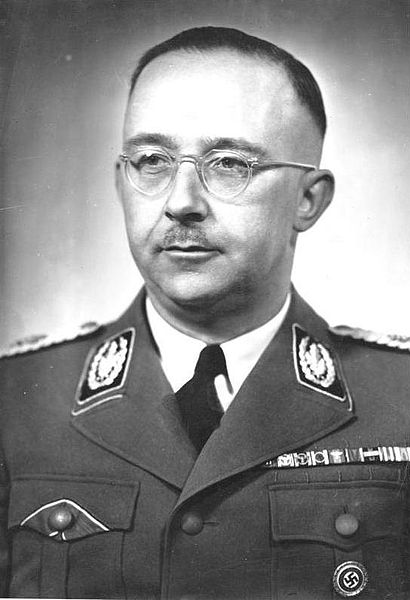
Heinrich Himmler
A member of the Nazi Party, a military leader and Reichsführer of the Schutzstaffel.
Name:
Heinrich Himmler
Publisher:
Real name:
Heinrich Luitpold Himmler
Aliases:
- Heinrich Hitzinger
- Zyklon
Birth date:
October 7th, 1900
Gender:
Male
Powers:
First issue:
The Black Terror (1942) #1 Trupp, the Master Saboteur

Origin
Born in Munich in 1900, Heinrich Himmler was raised in a Roman Catholic middle-class Bavarian family. He was an intelligent student, but his father, a principal, called him a born criminal. As a young man he was fascinated by the military and begged to be allowed to train with the army, which he eventually did. However, the war ended when he was only 18, dashing his hopes of becoming a professional officer. He participated in the Adolf Hitler's Beer Hall Putsch in 1922, but escaped jail time for his involvement. He married his wife, Margarete Boden, in 1928, and they separated in 1940 without divorcing. He was strongly tied to the ideology of getting "back to the land", and was a member, later leader, of the Artamanen group, which mixed racial ideology in with its agrarian ideals.Character Evolution
Himmler became a member of the Schutzstaffel (SS) in 1925, starting as a District Leader in Bavaria. In 1927 he became Deputy Reichsfuhrer and attained the rank of Oberfuhrer. In 1929 his predecessor resigned and Himmler became Reichsfuhrer of the SS, which at the time was just a wing of the Sturmabteilung (SA). He began to swell the ranks and fought to separate the SS from the SA. He was promoted to SS-Obergruppenfuhrer in 1933, a position which set him as an equal to the SA leaders. Himmler conspired with Hermann Goring to remove the head of the SA, Ernst Rohm, from power, which they succeeded in doing in 1934. At the same time, the SS became a separate organization and Himmler's rank, SS-Reichsfuhrer, became the highest attainable.In 1934, Goring transferred all power over the Gestapo to Himmler, making Himmler the chief of German Police outside of Prussia. In 1936 Hitler declared Himmler to be the Chief of German Police, effectively merging the police force with the SS and leaving the organization subordinate only to Hitler himself. He had control over all law enforcement and detection agencies, political or no. He was in control of the entirety of the concentration camp system, though after the beginning of the war there were some internment camps established over which he and the SS had no control. In 1943 the establishment of the Politische Staffeln removed the Gestapo monopoly of law enforcement power
Himmler was one of the main architects of the Holocaust, and was explicit and zealous in his desire to find a final solution to the "Jewish Problem". He oversaw the operation of concentration camps throughout the Reich, and opened the first, Dachau, in March of 1933. He visited and inspected concentration camps regularly, which led him to ponder the most expedient ways to murder masses of people, eventually settling on the gas chamber.
He was heavily immersed in mysticism, and ardently devoted to the ideals of Nazism. He believed in eugenics, and hoped to apply the principles of animal breeding to create a master Aryan race, the perfect Nordic ideal. He characterized the invasion of Russia ("Operation Barbarossa") as similar to the Crusades, a just cause to defend the values of Europe from the pollution of Bolshevism. He also created the plan ("Operation Konserve" or "Operation Himmler") to fabricate the appearance of Polish aggression so as to justify German military action and invasion.
In 1943 he was appointed Reich Interior Minister, replacing a long-time rival who had attempted to stem the flow of people being sent to concentration and extermination camps. This appointment merged the Interior Ministry with the SS. Later he was appointed head of the Reserve Army. He attempted to use this power to annex the civil service and to transfer policemen between the various arms of the SS, but was foiled by Martin Bormann and quickly discredited with the Nazi elite, including Hitler. After an attempt on Hitler's life, however, Himmler's Sicherheitsdienst (SD) became the sole intelligence service in Germany, increasing Himmler's powers immensely. Late in 1944 he became Commander-in-Chief of the Army Group Upper Rhine, which was formed to fight American and French troops that were encroaching on German territory along the Rhine. He was transferred away after some early successes, and the regiment ultimately was dissolved. Himmler then was put in control of Army Group Vistula, which was put in opposition to the Russian troops marching on Berlin. Himmler had no skill or experience with ordering troops, and resigned from his post in March.
He had lost faith in the chances of a German victory by late 1945. To this end, he attempted to negotiate a peace with General Dwight D. Eisenhower, as he felt that the only way Nazi Germany would survive would be if they were at peace with Britain and America. When his attempted surrender was broadcast by the Allied news media, Hitler flew into a rage, declaring Himmler to be a traitor. In his will he removed all of Himmler's offices and ranks, expelled him from the Nazi party and ordered him to be arrested. Himmler attempted to defect to the Americans, who refused to have anything to do with him, and was ultimately declared to be a war criminal. He attempted to escape into Bavaria but was noticed and arrested by the British in late May of 1945. He was to stand trial in Nuremburg along with the other Nazi war criminals, but he committed suicide while in custody by ingesting potassium cyanide on May 23, 1945.